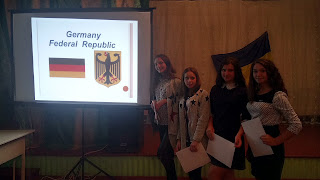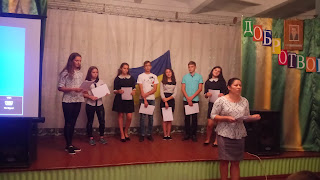Підвисоцька ЗШ І – ІІІ ст., ім. Т.Г.Шевченка
Підвисоцького НВО
ПОЗАШКІЛЬНИЙ ВИХОВНИЙ ЗАХІД
НА ТЕМУ:
«ЄВРОПЕЙСЬКИЙ ДЕНЬ МОВ. НІМЕЧЧИНА»
Підготувала:
Учитель
англ.мови
Класний
керівник 8 кл.
Шлапак
І.М.
Підвисоке
– 2017
Тема виховного заходу : « Європейський день мов. Німеччина »
Учасники : учні 8 – 11 класів.
Мета :
Практична: навчити
учнів самостійно здобувати знання із різних джерел і використовувати
їх на практиці.
Освітня: розширити світогляд учнів щодо спільної
європейської
спадщини та практичних умінь адаптуватися до
життя і навчання в різних країнах
Європи, бути мобільними, соціально здібними, здатними до комунікації і захисту своїх прав.
Розвивальна:
розвивати творчі здібності учнів до вивчення різних мов, активну розумову діяльність, культуру
почуттів і спілкування,захищати та не цуратись рідної мови.
Виховна: виховувати
позитивне ставлення до себе як особистості, повагу до людей і звичаїв інших країн;
виховувати культуру поведінки вільного часу; створити доброзичливу
емоційну атмосферу,бути відданим своїй батьківщині.( Використання спадщини В.Сухомлинського у процесі формування іншомовної
соціокультурної компетенції)
Міжпредметні зв’язки: основи інформатики, англійська мова, географія,історія,
українська мова та українська
література.
Обладнання: музичний
центр, комп’ютерна презентація, зображення прапорів європейських країн,
проектор.
Очікувані результати : засвоєння
інформації про Європейський День Мов; формування понять «дружби», «виховання»,
«взаємоповаги», «культурна спадщина», «збагачення свого власного світу»;
оволодіння навичками колективної роботи, саморозвитку, використання вивченого
матеріалу.
“Чужому навчайтесь,
свого не цурайтесь...”
Хід
виховного заходу
Учитель : Європа багата
мовами. Існує більше 200 європейських та інших світових мов, якими розмовляють
громадяни походженням з інших континентів. Святкування Європейського Дня Мов
робить акцент на тому, що вивчення мови допоможе не тільки розширити свої
горизонти і вільно спілкуватися з носіями, а й долучитися до культури цих
народів. Підготовкою до свята були охоплені учні 8 - 11 класів, презентовані
відеоролики, цікаві факти. Такі заходи зацікавлюють і спонукають молодь вивчати
іноземні мови.
“Чужому навчайтесь,
свого не цурайтесь...”
Напевно ці слова Т.Шевченка в певній мірі стосуються і процесу вивчення та
викладання іноземної мови. Неможливо переоцінити значення глибоких знань з
іноземної мови у сучасному світі.
Шкільна програма вивчення іноземної мови включає багате різноманіття тем
краєзнавчого, громадсько-суспільного, історичного та побутового характеру. Але
тема "Україна" проходить через увесь програмний курс іноземної мови у
школі. Уроки-диспути, заочні подорожі в історичне минуле, написання творчих
робіт та їх захист перед великою аудиторією сприяє поглибленню знань учнів з
цих питань. Виходячи з проблеми національного виховання учнів, велика увага
приділяється вивченню історії, культури, традицій та звичаїв українського народу.
Враховуючи індивідуальні особливості учнів : розвинутий художній смак,
сценічна майстерність, творчий підхід до вирішення проблем, почуття краси та
гармонії, вчитель має можливість створити сприятливу атмосферу свідомого
оволодіння знаннями з іноземної мови і зробити цей процес цікавим.
І тут на допомогу має прийти досвід Школи радості В.О.Сухомлинського. Наша
рідна земля, Кіровоградщина, пов'язана з ім'ям цього всесвітньо-визнаного
народного вчителя України, нашого земляка.
В. О. Сухомлинський навчав дітей слухати, читати, розуміти й творити казку.
В процесі її пізнання учні усвідомлюють, що таке алегоричність. Вони вчаться
асоціативно мислити, фантазувати, помічати проблемні ситуації, шукати їх
вирішення. Учні думають над тим, що слід робити, аби завжди перемагало добро.
В. О. Сухомлинський зауважував: “Якщо дитина не відчуває радості від того,
що особисто комусь робить добро, а тільки "споживає" добро, що
творять інші, вона ніколи не стане справжньою людиною”.
Павлишські казки В. Сухомлинського вміщують потужний потенціал для
виховання і формування високих моральних якостей особистості. А перекладені на
англійську мову, вони можуть бути вдало використані під час навчання різним
аспектам англійської мови (аудіювання, читання, усне мовлення, письмо).
Одна з головних
проблем – формування мотивації
навчання. В.О. Сухомлинський вважав,
що важливою умовою формування інтересу до навчання,
позитивних мотивів учіння є навчання на досить високому рівні трудності.
В своїй книзі "Серце віддаю дітям" педагог писав, що діти повинні
зрозуміти саму суть інтелектуальної праці , яка полягає в напруженні розумових
сил, проникненні в різноманітні тонкощі, деталі, суперечливість речей, фактів,
явищ. Подолати байдуже ставлення учня до навчання, на його думку, неможливо без
впливу на емоційну сферу дитини.
В.О. Сухомлинський стверджував, якщо подібне відкриття схвилювало дитину і
думка злилася з почуттям, знання стають її переконанням на все життя.
Саме цього і прагне досягти кожен вчитель, саме це і є логічним результатом
процесу навчання.
Тож, сьогодні, ми ще раз впевнимось, що вивчати щось інше і нове,це не
тільки цікаво,але і корисно, беручи приклад з таких шанованих людей,як В.
Сухомлинський.
Сьогодні нам випала нагода дізнатись більше про таку країну,як Німеччина.
Про її національні традиції та звичаї. Про її страви та одяг, та багато іншого
і цікавого.
Teacher: Europe is rich in languages. There
are over 200 European and other world languages spoken by citizens of origin
from other continents. The celebration of the European Year of Languages
emphasizes the fact that language learning will help not only to expand its
horizons and communicate freely with carriers, but also to engage in the
culture of these peoples. Preparations for the holiday were covered by pupils
of grades 8-11, presented videos, interesting facts. Such measures are of
interest and encourage young people to study foreign languages.)
Pupil 1Germany is at the center of Europe, not only
geographically, but also in terms of politics and economics. The country is
Europe's second most populous after Russia, with more than 81 million people,
according to the World Factbook. The German economy is the largest on the
continent and the fifth largest in the world.
While German exerts its influence on the countries that border it —
Austria, Belgium, Czech Republic, Denmark, France, Luxembourg, Netherlands,
Switzerland and Poland — all of these cultures have, in varying degrees, had a
hand in shaping today’s Germany. The population is 91.5 percent German, with
Turkish being the second largest ethnic group at 2.4 percent, according to the
World Factbook. The remaining 6.1 percent is made up primarily of those of
Greek, Russian, Italian, Polish, Serbo-Croatian and Spanish descent.
(Video about Germany)
Pupil 2:
Germans
place a high priority on structure, privacy and punctuality. The German people
embrace the values of thriftiness, hard work and industriousness and there is
great emphasis on making sure that "the trains run on time."
According to Passport to Trade 2.0, an online business etiquette guide by the
University of Salford in Manchester, England, "Germans are most
comfortable when they can organize and compartmentalize their world into
controllable units. Time, therefore, is managed carefully, and calendars,
schedules and agendas must be respected."
Germans are
stoic people who strive for perfectionism and precision in all aspects of their
lives. They do not admit faults, even jokingly, and rarely hand out
compliments. At first their attitude may
seem unfriendly, but there is a keen sense of community and social conscience
and a desire to belong.
Pupil 3: Languages
Unsurprisingly,
the official language of the country is German. More than 95 percent of the
population speaks German as their first language, according to Angelo State
University's Center for International Studies. Other languages spoken include
Serbian in eastern Germany; North and West Frisian, spoken around the Rhine
estuary; and Danish, primarily spoken in the area along the Danish border.
Romani, which is an indigenous language, Turkish and Kurdish are also spoken.
Pupil 4: Religion
Christianity is the dominant religion, with 65 to 70 percent of the
population identifying themselves as Christian. That number includes 24 million
Catholics, according to CBS News. Muslims make up 3.7 percent of the
population, according to Angelo State University, while 28.3 percent are
unaffiliated or have a religion other than Christianity or Islam.
Pupil 5: German
food and drink
Germans
love rich, hearty cuisine, though each area of Germany has its own definition
of what a traditional meal looks like.
Pork is the most consumed meat, according to the German Food Guide.
Schweinshaxe (braised pork hock) and Saumagen (pork stomach) is a couple of
traditional pork dishes.
Bratwurst, a form of sausage, is closely associated with German food.
Cabbage, beets, and turnips are commonly incorporated into meals, as they are
native to the region, and potatoes and sauerkraut are also stars of German
cuisine.
Beer is the
most popular alcoholic beverage, and the country is known as the birthplace of
a number of beer varieties, including Pilsner, Weizenbier (wheat beer) and Alt.
These beers were crafted according to Reinheitsgebot, or the "Purity
Law," a 16th-century Bavarian law that decreed that beer could only be
brewed from barley, hops and water, according to NPR. Brewers used the yeast
available in the air. Brandy and schnapps are also favorite German alcoholic
beverages.
Pupil
6: The Arts
Culture doesn't just refer to how people interact and look.
"Culture also means refined intellectual, artistic and creative
achievement, for example as in cultural knowledge, or a cultured person,"
Cristina De Rossi, an anthropologist at Barnet and Southgate College in London,
told Live Science.
Germans have made tremendous contributions to classical music, and the
traditions of famous German or Austrian composers such as Johann Sebastian
Bach, Wolfgang Amadeus Mozart, Ludwig van Beethoven, Johannes Brahms, Richard
Wagner and Gustav Mahler live on today.
With their penchant for precision and engineering, it is not surprising
that Germans have a strong tradition of printmaking by woodcut and engraving.
There is also a strong representation of all phases of architecture — including
Romanesque, Gothic, Classicist, Baroque, Rococo and Renaissance — represented
in cathedrals, castles and public buildings. One well-known example of classic
German art is the Brandenburg Gate, a former city gate that is now used to
symbolize Berlin's unity. (Video about German Arts)
Pupil 7: Business culture
The desire for orderliness spills over into the business life of
Germans. Surprises and humor are not welcomed. Everything is carefully planned
out and decided upon, with changes rarely occurring after an agreement is made,
according to the German Business Culture Guide.
There is a high regard for engineers in German, as evidenced by the
country’s success in the automotive industry. Because of this high level of
respect for hands-on expertise, companies tend to be headed by technical
experts rather than lawyers or those with a financial background.
Pupil 8:Holidays and celebrations
Germany celebrates many of the traditional Christian holidays, including
Christmas and Easter. German Unification Day on October 3 marks the reuniting
of East and West Germany and is the only federal holiday.
While the country’s big beer bash is called "Oktoberfest," its
starts each year on a Saturday in September and ends 16 to 18 days later, on
the first Sunday in October. The tradition started in 1810, with the wedding of
Crown Prince Ludwig of Bavaria to Princess Therese von Sachsen-Hildburghausen,
according to the city of Munich. (Video about German Holidays)
Teacher: So, today, we are learning more about country is
Germany. I think we were get together more and more and learn about different
countries and other thins. Thank you for your attention and good bye.










Комментарии
Отправить комментарий